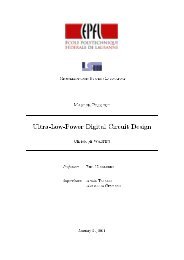Compressive Sensing system for recording of ECoG signals in-vivo
Compressive Sensing system for recording of ECoG signals in-vivo
Compressive Sensing system for recording of ECoG signals in-vivo
You also want an ePaper? Increase the reach of your titles
YUMPU automatically turns print PDFs into web optimized ePapers that Google loves.
6. Analog Path Design6.1. Design DiscussionThe multipath neural acquisition <strong>system</strong> <strong>for</strong> a channel that is shown <strong>in</strong> Fig.3.4.1 has beenchosen as the implementation to be developed. It is <strong>in</strong>cluded aga<strong>in</strong> below as reference dur<strong>in</strong>gthe design discussion. Hav<strong>in</strong>g a look <strong>of</strong> the complete design it is clear that the complexity <strong>of</strong>implement<strong>in</strong>g all <strong>of</strong> the blocks overcomes the scope <strong>of</strong> a f<strong>in</strong>al master thesis, and so, <strong>in</strong> order to<strong>in</strong>troduce design improvements, the design has had to be limited to some blocks, putt<strong>in</strong>g <strong>of</strong>f thetotal implementation <strong>for</strong> future steps <strong>in</strong> the CS field.As it is commented <strong>in</strong> the Chapter 1 and 2, the ma<strong>in</strong> constra<strong>in</strong>ts <strong>of</strong> the <strong>system</strong> are: a) area, dueto the act that the chip to be placed over <strong>in</strong>dividuals bra<strong>in</strong> has to be as smaller as possible, andso less <strong>in</strong>vasive; and b) power consumption, because <strong>of</strong> the fact that a large battery cannot be<strong>in</strong>cluded <strong>in</strong> the <strong>system</strong>, and overall safety issues, because low power consumption means lowheat dissipation and so the chip will be permitted as bioapplication. By the other hand, the<strong>system</strong> is not conditioned by time constra<strong>in</strong>ts, so any extra ef<strong>for</strong>t is employed <strong>in</strong> order to make ahigh-speed design. That is s<strong>in</strong>ce real neural <strong>signals</strong> have a low bandwidth, and so there is noreason <strong>in</strong>to exploit high-speed features which will be not used.By consider<strong>in</strong>g the ma<strong>in</strong> blocks <strong>of</strong> the <strong>system</strong>, and the design problems with which each <strong>of</strong> themis related, it is stated that the LNA, the ADC and the multiplexer boil over the time limitations,and so, previous designs are considered. By the other hand, a good design <strong>of</strong> howimplement<strong>in</strong>g the mix<strong>in</strong>g and <strong>in</strong>tegration blocks have not been already done <strong>in</strong> the state <strong>of</strong> theart, and so, it has been considered as the best feasible design to be completed under thescenario <strong>of</strong> this project. The ma<strong>in</strong> goal <strong>for</strong> be<strong>in</strong>g considered <strong>in</strong> the improvement is area sav<strong>in</strong>g<strong>in</strong> order to achieve an architecture <strong>in</strong> which the m<strong>in</strong>iaturization <strong>of</strong> the <strong>in</strong>tegration capacitances,which regard<strong>in</strong>g the literature are too large components <strong>of</strong> the <strong>in</strong>tegrator circuitry, could be carryout. Along the next po<strong>in</strong>ts the different blocks <strong>of</strong> the multipath analog approach are analyzed <strong>in</strong>details.A discussion about the amplification and conversion operations has been <strong>in</strong>cluded <strong>in</strong> AppendixE. In order to address the mixer-<strong>in</strong>tegrator design, the same parameters which have beenconsidered dur<strong>in</strong>g the Matlab and Simul<strong>in</strong>k models are taken <strong>for</strong> the circuitry design <strong>in</strong>Cadence. They are referred <strong>in</strong> Table 5.1. The same synthetic <strong>in</strong>put signal that has been used<strong>for</strong> Matlab-Simul<strong>in</strong>k simulations has been <strong>in</strong>troduced <strong>in</strong>to Cadence model. Similarly, the randommatrices which have been considered are those based on the new random generator presented<strong>in</strong> Chapter 4 and the one which can be generated by rand<strong>in</strong>t <strong>in</strong> Matlab.54















